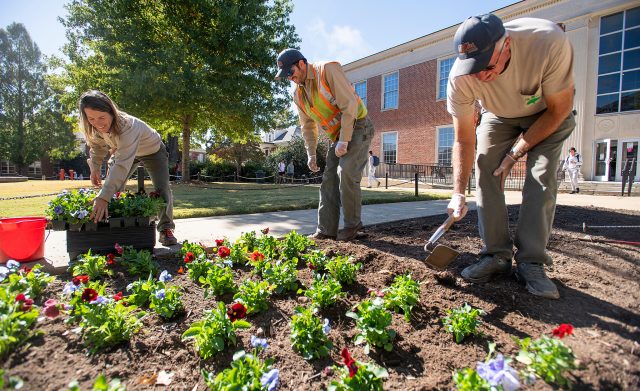
Workers for the Department of Landscape Services replant a flower bed on the Ole Miss campus. With proper preparation and attention to planting details, anyone can achieve beautiful results for their home landscape. Photo by Thomas Graning/Ole Miss Digital Imaging Services
OXFORD, Miss. – When it comes to beautifying lawns and gardens, Jeff McManus knows his way around the grounds.
As director of landscape services at the University of Mississippi, McManus has built a national reputation for excellence, resulting in the Ole Miss campus repeatedly being recognized as one of the most beautiful in the country.
McManus was asked to share some of his secrets. Here’s his tips:
UM: When is the best time to plant flowers?
McManus: With seasonal flowers, there are annual and perennial varieties of flowers that may need to be planted at different times. Annuals, which flower for one season – summer or winter – in Mississippi, will have to be planted every year; whereas perennials may return each year or will need to be replanted only once the previous flower has lived its full life.
Cool-season annuals such as pansies are planted in the fall once the temperature gets cooler. Warm-season annuals such as begonias, penta and lantana can be planted in spring after the last threat of frost has passed.
Fall is a good time to plant perennial varieties, such as day lilies and iris.
UM: Is there a best time to plant a shrub?
McManus: Evergreen and deciduous shrubs – sometimes called a “bush,” depending on the variety – like to be planted in the fall when temperatures are cooler. If irrigation is not available, wait for the first frost when temperatures get colder to plant.
You can plant shrubs in other seasons, and they will often thrive, but fall is cool enough where there is no above-ground growth, so all the growth is in establishing the roots. Fall can be a good moist season, while spring and summer may require a plant to be watered to keep it from drying out. The next best time is very early spring.
UM: And what about tree-planting?

Jeff McManus (right), UM director of landscape services, leads a Luckyday class in planting trees around the Luckyday Residential College. Photo by Logan Kirkland/Ole Miss Digital Imaging Services
McManus: To give it the best chance to survive, try to plant the tree in fall or early spring. For much of the same reason listed for shrubs above.
UM: What are the best types of potting soils for certain types of plants?
McManus: Choosing a potting mix may seem simple, but not all mixes are created alike.
When buying potting mix for containers, I look for mixes with ingredients that will help my plants thrive. A potting mix I like to use is a blend of peat moss, pine bark fines, perlite, sand and a small bit of fertilizer.
The mixes vary from brand to brand and a blend one company calls potting soil might be called potting mix by another.
I have found the quality of the mix has a direct relation to the price on the bag. I will pay more for potting mix to give my plants a good foundation. Lower quality potting products may not have been manufactured consistently and may break down faster than higher quality merchandise.
When it comes to potting soil for flower beds, I like make sure it contains some native soil or keep my native soil in the mix. I like pine bark fines or composted wood fiber. When mixed with the soil in a flower bed, this will give you an excellent growing bed for outdoor flowers.
UM: How often should one check plants for damage? What should they be on the lookout for? Given the uncertainty of nature, what should people do to protect their plants in the event of extreme cold, winds or no rainfall?
McManus: Most people will be walking outside and will notice their plants’ condition, that something is out of place or a plant is showing signs of stress.
Exterior landscape plants are meant for outdoors, and if you plant Zone 7 (year-round) plants, you most likely will not have many issues with cold weather.
When temperatures drop from mild to extreme cold in less than 24 hours, that is generally when we see plant damage and even death. It is best to wait until spring to see what has lived or not made it.
A lot of plants will lose their leaves that usually do not because the temperatures got so cold, but the plants are not dead. Many will push new growth back when temperatures start to warm up. There may be some plants that need more pruning to remove the dead material.
For more on UM Landscaping Services, click here.